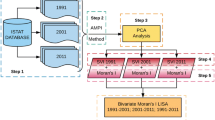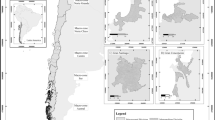Abstract
Based on the obtained population vulnerability values of geological disasters (including landslide, collapse, debris flow and land collapse) in 31 provincial administrative units in China, their spatial pattern is analyzed by the global indicators of spatial association (Global Moran’s I) and the local indicators of spatial association (Local Moran’s I, i.e., LISA), and the reasons for the formation of their spatial pattern are discussed from the perspectives of population exposure, population capacity and environmental conditions around people. The results show that there is a positive spatial autocorrelation of population vulnerability to geological disasters in the study area, which is a spatial cluster distribution. The high value of population vulnerability to geological disasters is concentrated in the Southwest and Central of China, while the low value is concentrated in Northeast China. And their spatial pattern is mainly caused by the spatial aggregation and superposition of population capacity and environmental conditions around people.





Similar content being viewed by others
References
Fischer MM, Getis A (2010) Handbook of applied spatial analysis: software tools, methods and applications. Springer-Verlag, Berlin
Hossain MK, Meng QM (2020) A multi-decadal spatial analysis of demographic vulnerability to urban flood: a case study of Birmingham City, USA. Sustainability 12:9139
Liu XL, Miao C (2018) Large-scale assessment of landslide hazard, vulnerability and risk in China. Geomatics, Nat Hazards Risk 9:1037–1052
Liu Y, Yang Y (2012) Spatial distribution of major natural disasters of China in historical period. Acta Geograph Sin 67:291–300
Liu XL, Yu CJ, Shi PJ, Fang WH (2012) Debris flow and landslide hazard mapping and risk analysis in China. Front Earth Sci 6:306–313
Liu YJ, Chen J, Pan T (2021) Spatial and temporal patterns of drought hazard for China under different RCP scenarios in the 21st century. Int J Disaster Risk Reduct 52:101948
Lu YL, Yan L, Xu XG (2010) Ecological vulnerability assessment and spatial auto-correlation analysis over the Bohai Rim Region. Resources Sci 32:303–308
Miao C, Ding MT (2015) Social vulnerability assessment of geological hazards based on entropy method in Lushan earthquake-stricken area. Arab J Geosci 8:10241–10253
Miao C, Ding MT (2017) Comparative analysis of social vulnerability of seismic areas: a case study of Lushan earthquake and Ludian earthquake. China Saf Sci J 27:169–174
Miao C, Teng JK, Wang J, Zhou P (2018) Population vulnerability assessment of geological disasters in China using CRITIC–GRA methods. Arab J Geosci 11:1–12
Ni SH, Gu Y, Peng YJ, Liu JN, Wang HL (2019) Spatio-temporal pattern and evolution trend of drought disaster in China in recent seventy years. J Nat Disasters 28:176–181
Okunola OH (2019) Spatial analysis of disaster statistics in selected cities of Nigeria. Int J Emerg Manag 15:299–315
Peng L, Liu SQ (2013) Evaluation and spatial pattern analysis of rural development system in Three Gorges Reservoir Area. Trans Chin Soc Agric Eng 29:239–249
Roy Soma S, Roy Shouraseni S (2021) Spatial patterns of long-term trends in thunderstorms in India. Nat Hazards 107:1527–1540
Shen S, Cheng CX, Song CQ, Yang J, Yang SL, Su K, Yuan LH, Chen XQ (2018) Spatial distribution patterns of global natural disasters based on biclustering. Nat Hazards 92:1809–1820
Shi PJ (2016) Natural disasters in China. Springer, Berlin
Song H, Chen XL (2006) Application of spatial autocorrelation analysis to the spatial pattern of inbound tourism increase in China. World Reg Stud 15:99–106
UNISDR (2015) Sendai framework for disaster risk reduction 2015–2030. The United Nations Office for Disaster Risk Reduction, Geneva
Wang Z, Zhang XD, Su W, Yang SQ, Liu SC (2010) Spatial autocorrelation of three nature disasters in China. Trans CSAE 26:302–306
Wang Y, Liu TX, Li TS, Lin QG, Lin L, Song CZ (2017) Study on spatial pattern of small and medium sized natural disasters in China: a case of earthquake, flood and drought. J Nat Disasters 26:48–55
Wang Y, Lin QG, Shi PJ (2018) Spatial pattern and influencing factors of landslide casualty events. J Geogr Sci 28:259–274
Wei C, Guo B, Zang W, Yang F, Zhang R (2021) Temporal and spatial evolution patterns of drought in China over the past 500 years. Arab J Geosci 14:776
Yang GG, Yang YZ, You Z, Zhang XY (2011) The temporal and spatial distribution pattern of earthquake disaster in Chinese Mainland. Adv Earth Science 26:548–555
Yang MX, Mou YL, Meng YR, Liu S, Peng CH, Zhou XL (2020) Modeling the effects of precipitation and temperature patterns on agricultural drought in China from 1949 to 2015. Sci Total Environ 711:135139
Acknowledgements
This study was financially supported by the National Natural Science Foundation of China (Grant No. 41871174), the “Chunhui Plan” of International Cooperation and Exchange Department of Ministry of Education of China (Grant No. CH2019dmt), and the Project of Science and Technology Department of Sichuan Province (Grant No. 2020YFSY0013)
Author information
Authors and Affiliations
Corresponding author
Ethics declarations
Conflict of interest
The authors declare that they have no competing interests.
Additional information
Responsible Editor: Amjad Kallel
Rights and permissions
Springer Nature or its licensor holds exclusive rights to this article under a publishing agreement with the author(s) or other rightsholder(s); author self-archiving of the accepted manuscript version of this article is solely governed by the terms of such publishing agreement and applicable law.
About this article
Cite this article
Miao, C., Ding, M. Spatial pattern analysis of population vulnerability to geological disasters in China. Arab J Geosci 15, 1507 (2022). https://doi.org/10.1007/s12517-022-10726-x
Received:
Accepted:
Published:
DOI: https://doi.org/10.1007/s12517-022-10726-x




